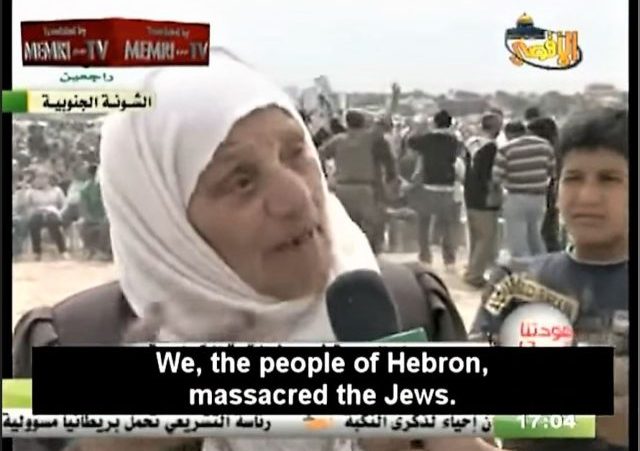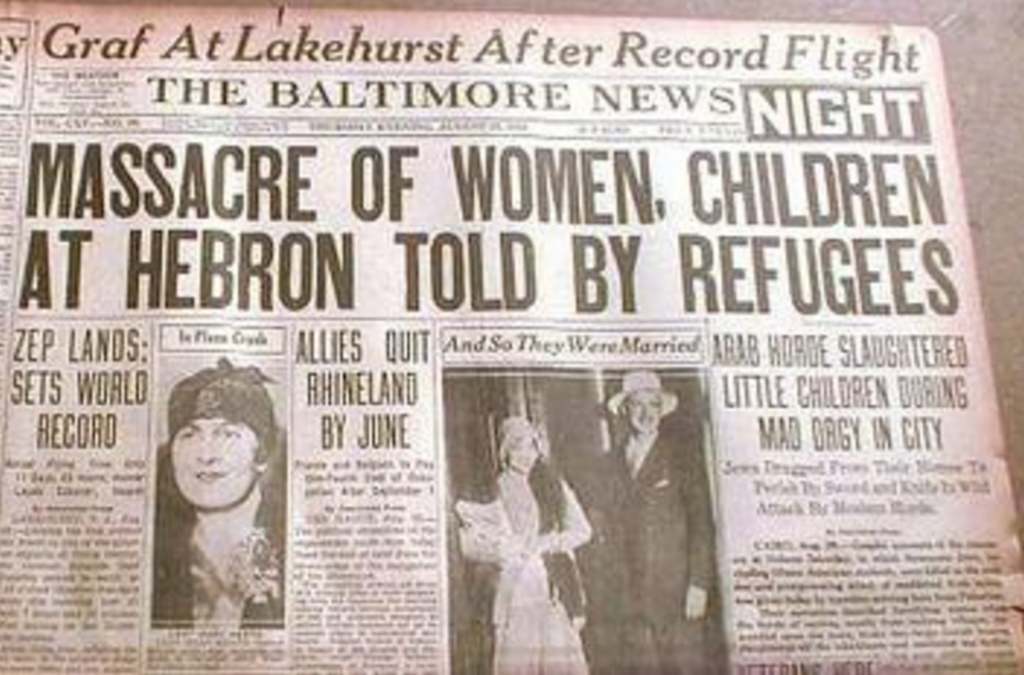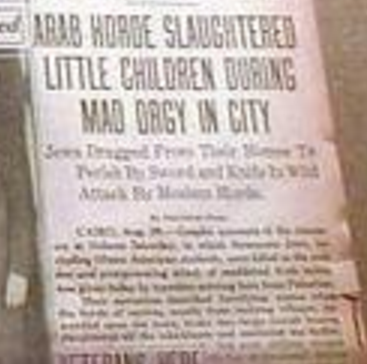90th Anniversary of Arab Massacre of Jews in Hebron and Safed
If you don’t understand Hebron and Safed 1929, you don’t understand the conflict.

Ninety years ago, in 1929, Arabs went on a murderous anti-Jewish rampage in the British Mandate for Palestine, ransacking ancient Jewish communities in Hebron and Safed (Tzefat). In the course of the week, a total of 130 Jews were dead.
We covered the 1929 Hebron Massacre in 2016, Anniversary of 1929 Hebron Massacre and Ethnic Cleansing of Jews:
Hebron is a hot spot in many ways. Hebron and its immediately surrounding Arab areas are the single largest source of terror attacks during the so-called Knife or Stabbing Intifada.
It’s also a place where anti-Zionist and left-wing “liberal Zionist” American Jews love to gather to protest the Jewish “settlers” who live in a tiny section of the city. That section is under Israeli military control by agreement with the Palestinian Authority, with good reason. Hebron has a long history of violence directed at Jews.
Hebron also is the place of the Cave of the Patriarchs, which I visited in 2015.
Hebron had one of if not the oldest continuous Jewish communities in the world, dating back several hundred years at least. Until 1929.
On August 23, 1929, the Arabs attacked the Jews of Hebron along with numerous other Jewish communities.
But in Hebron it was particularly vicious. It was a blood frenzy in which the Jews were set upon with particular glee and slaughtered with knives, machetes and anything else available.
This old Palestinian woman remembered the massacre fondly:
Interviewer: Please tell us who you are.
Sara Jaber: I am from Hebron. The Jaber family.
Interviewer: What is your name?
Sara Jaber: Sara Muhammad ‘Awwadh Jaber.
Interviewer: How old are you?
Sara Jaber: I am 92.
Interviewer: So you remember May 15, 1948, the day of the Nakba.
Sara Jaber: Why wouldn’t I remember? May Allah support us. I hope we forget those days. Allah willing, you will bury [Israel], and massacre the Jews with your own hands. Allah willing, you will massacre them like we massacred them in Hebron.
Interviewer: What does this day mean to you? You have lived 63 years since the Nakba. You have experienced the entire Nakba…
Sara Jaber: 92 years. That’s 92. I lived through the British era, and I lived through the massacre of the Jews in Hebron. We, the people of Hebron, massacred the Jews. My father massacred them, and brought back some stuff…
Interviewer: Thank you very much.
We have not previously covered the massacre in Safed:
On Friday August 23, the violence moved outside the confines of Jerusalem, to many other parts of the country as bands of Arabs attacked the Jews. In many locations, the mobs were joined by Arab policemen. Attacks on Jews in the cities of Tel Aviv and Haifa were well-defended by armed Jews, while Hebron suffered the worst with the cruel slaughter of 67 Jewish men and women. In Safed, 18 Jews were killed. Altogether, across the country, there were 133 Jewish deaths and more than 300 injured….
Two days later, [David] Hacohen managed to find his way to the town where the Jewish elders of the cities fell upon him weeping bitter tears. Said Hacohen, “Inside the houses I saw the mutilated and burned bodies of the victims of the massacre, and the burned body of a woman tied to the grille of a window.”
Referring to the marauding Arabs, Hacohen continued, “They slaughtered the schoolteacher, Aphriat, together with his wife and mother, and cut the lawyer, Toledano, to pieces with their knives. Bursting into the orphanages, they smashed the children’s heads and cut off their hands. I myself saw the victims.”
The total loss to Jewish life and property was 18 killed, about 40 wounded and 200 houses burned and looted.
These events are important.
They reflect the deep hatred of Jews two decades before Israel declared independence, directed at Jewish communities that were hundreds of years old. The conflict is not about 1948 (Israel’s independence) or 1967 (Israel’s recapture of the West Bank from Jordan), but about an Islamic Jihadist hatred of Jews described by historian Benny Morris:
What I discovered in the documentation relating to the [1948] war, at least from the Arab side, was that the war had a religious character, that the central element in the war was an imperative to launch jihad. There were other imperatives of course, political and others—but the most important from the enemy’s perspective was the element of the infidels who had the nerve to take control over sacred Muslim lands and the need to uproot them from there. The decisive majority in the Arab world saw the war first and foremost as a holy war, but until today historians have not examined the documentation that proves this.
That past is present. Hebron, where Jews returned to the small Jewish section, is a center of Hamas activity. A large Israeli military presence, by agreement of the Palestinian Authority, is needed to prevent another massacre of Jews. Yet that military presence, and checkpoints, is used to demonize Israel by western activists. But if there were no threat of another massacre, there would be no need for the military presence.
The past also is present in the supposedly moderate Palestinian Authority, which glorifies the murderers in the 1929 massacre. PalMedia Watch reports:
Today marks 90 years since the Hebron Massacre of 67 Jews. Rampaging Arabs also murdered Jews in Jerusalem and Tzefat. In total, in the course of just one week, Arabs murdered 130 Jews.
While the massacre took place in 1929, over 60 years before its creation, the Palestinian Authority has wholeheartedly adopted the event, glorifying three of its participants and perpetuating the spark that ignited the massacre.
In the aftermath of the massacres, British mandate forces arrested and prosecuted dozens of Arabs. While most of the death sentences handed down were commuted to life imprisonment, three Arabs who, according to a report by the British government to the League of Nations, “committed particularly brutal murders at Safad and Hebron” were put to death on June 17, 1930.
Every year the PA marks the execusion of these three murderers – Muhammad Jamjoum, Fuad Hijazi, and Ataa Al-Zir.
In June this year, on the 89th anniversary of their execution, PA TV marked the execution of “the three heroes” and used the opportunity to add that they have become “a legend of self-sacrifice for the homeland” and that “souls that have been sacrificed for their country will not die.” In this manner, the PA constantly reinforces its message that dying while carrying out an act of terrorism is an outcome that guarantees that the souls of the terrorists do not die.
If you don’t understand Hebron and Safed 1929, you don’t understand the conflict.
 DONATE
DONATE
Donations tax deductible
to the full extent allowed by law.











Comments
Thanks for posting this. Somehow I had missed the 2016 post and was totally unaware of the massacre.
Never forget.
I’ve read Geert Wilder’s book and he quotes the Koran. What do you expect from a religion that follows a psychopath?
“What do you expect from a religion that follows a psychopath?”
I predict an entire region of psychopaths.
I also thank you for posting this. I am reminded once again that there is absoltely zero historical, legal, religious, moral or practical justification for a “Palestinian” state.
When Israel took Judæa in 1967, the Arabs of Hevron, fearing that the Jews would treat them as they would do in the same circumstances, fled before the IDF could get there. Rabbi Shlomo Goren somehow got to Hevron before the IDF forces, and found a ghost town. But rather than take the gift God had given Israel, Moshe Dayan chased down the Arabs and invited them back.
A few years later some Jews decided to move back to Hevron. They got permission from Jews who owned property there, survivors of the massacre or their heirs. The Israeli government refused to let them settle there, and instead established the nearby town of Kiryat Arba.
Jews could not live in Hevron until 1979, when a group of women and children broke into Beit Hadassa, a former hospital that had been operated by the American Hadassa women’s organization until 1929, and was lying empty, and barricaded themselves inside. Had they been men the IDF would just have dragged them out, but the government didn’t want pictures of IDF soldiers brutally dragging women and children out so they decided to wait until the women left and then not let them back in. For a year the women stayed there, with no electricity or heating, while their husbands brought them food and supplies.
A year later, after six Jews were murdered in Hevron, the government finally agreed to allow a small group of Jews to settle in the city, but only in a few buildings. For the last 35 years the Jews have been trying to buy more buildings from Arabs, or to move into buildings still owned by Jews, and every single time the government stops them. Every once in a while the government allows them to occupy one more building, and that’s a huge deal.
The centuries-old Avraham Avinu synagogue had been in ruins. The Arabs had used it as a goat-pen and a public toilet. The Israeli government refused to allow it to be rebuilt. One brave man, Professor Bentzion Tauger, a former dissident in the USSR, started rebuilding it, and dared the army to stop him. He proclaimed that he had sat in a Soviet prison for Zion, and was prepared to do the same in an Israeli prison. He was arrested many times but never charged and eventually the synagogue was reopened.
There’s more, but I’m out of time for now. The bottom line is after the Arabs, the biggest opponent of the Jewish community in Hevron is the Israeli government and army. It’s a crying shame.
One of the most important passages of the article to which the professor linked (i.e., https://www.safed.co.il/safed-massacre-of-1929.html) is this (emphasis added):
History such as this explains at least one of the reasons we need to protect the 2nd Amendment (and avoid regulations and laws that inhibit that Amendment).
Things like this, and other sabotage by the Israeli government, confused me a great deal when I was growing up. I grew up in a Jewish secular family. We didn’t particularly discuss Israel, but I saw reports on the news. And I tried to understand who was on what side and what they wanted.
Any chance that I would be sympathetic to the Israeli side was made too difficult for me, because no such side was visible. They would have meetings and agreements, and Shimon Peres would say something and something different, and Yasser Arafat would say something, and these guys seemed to spend a lot of time negotiating garbage. The best I could figure out is that both sides wanted to fight and keep instability going, and they loved having these high level negotiations and free food in fancy hotels and being on the news, and that may all be true. But it confused me a lot, for many years.
I should clarify to be sure, I don’t want to minimize anything about the real atrocities that have gone on and that continue to go on. I couldn’t even see things going on there as atrocities, because the behavior of the Israeli leaders did not match what would be logical when one’s people is subjected to atrocities. They seemed to want to dance with the enemy rather than to vanquish the enemy. So was it really an enemy or a dance pertner, excuse me, “partner for peace”?
My view now is that of Meir Kahane: move the foreigners out of the Promised Land, and let them pretend that’s “genocide” or whatever, but move them. If that’s possible.
Actually Rabbi Kahane was fine with letting Arabs stay as legal resident aliens, so long as they acknowledge that it’s not their country.
A death cult that should have been exterminated in 1967.
Thank you Professor